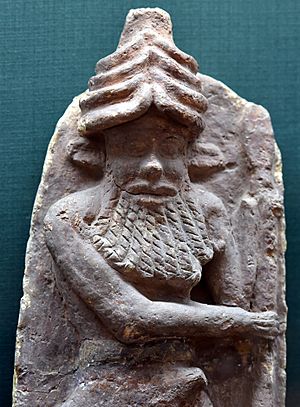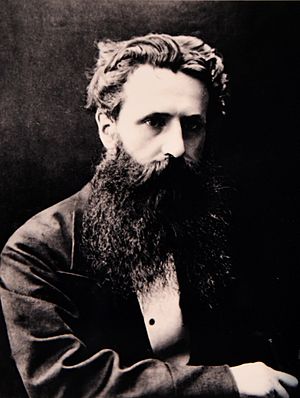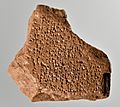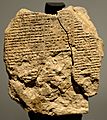Epic of Gilgamesh facts for kids

The Epic of Gilgamesh is an epic poem from ancient Mesopotamia. It is one of the earliest works of literary fiction known.
The most complete version that exists today was preserved on twelve clay tablets in the library collection of the 7th century BC Assyrian king Ashurbanipal.
A series of Sumerian legends and poems about the mythological hero-king Gilgamesh were probably gathered into a longer Akkadian poem some time before the 7th century BC.
The epic is widely read in translation, and the hero, Gilgamesh, has become an icon of popular culture.
Contents
History

Some 15,000 fragments of Assyrian cuneiform tablets were discovered in the Library of Ashurbanipal in Nineveh by Austen Henry Layard, his assistant Hormuzd Rassam, and W. K. Loftus in the early 1850s. Late in the following decade, the British Museum hired George Smith to study these; in 1872, Smith read translated fragments before the Society of Biblical Archaeology, and in 1875 and 1876 he published fuller translations.
From the diverse sources found, two main versions of the epic have been partially reconstructed: the Standard Babylonian version, or He who saw the deep, and the Old Babylonian version, or Surpassing all other kings. Five earlier Sumerian poems about Gilgamesh have been partially recovered, some with primitive versions of specific episodes in the Babylonian version, others with unrelated stories.
Translations
The first direct Arabic translation from the original tablets was published in the 1960s by Iraqi archaeologist Taha Baqir.
The definitive modern translation is a two-volume critical work by Andrew George, published by Oxford University Press in 2003. A book review by Cambridge scholar Eleanor Robson claims that George's is the most significant critical work on Gilgamesh in the last 70 years. George discusses the state of the surviving material, and provides a tablet-by-tablet exegesis, with a dual language side-by-side translation.
In 2004, Stephen Mitchell supplied a controversial version that takes many liberties with the text and includes modernized allusions and commentary relating to the Iraq War of 2003.
In 2021, a translation by Sophus Helle was published by Yale University Press.
Content of the tablets

The first half of the story discusses Gilgamesh, king of Uruk, and Enkidu, a wild man created by the gods to stop Gilgamesh from oppressing the people of Uruk. Enkidu travels to Uruk, where he challenges Gilgamesh to a test of strength. Gilgamesh wins the contest; nonetheless, the two become friends. Together, they make a six-day journey to the legendary Cedar Forest, where they plan to slay the Guardian, Humbaba the Terrible, and cut down the sacred Cedar. The goddess Ishtar sends the Bull of Heaven to punish Gilgamesh. Gilgamesh and Enkidu kill the Bull of Heaven after which the gods decide to sentence Enkidu to death and kill him.
In the second half of the epic, distress over Enkidu's death causes Gilgamesh to undertake a long and perilous journey to discover the secret of eternal life. He eventually learns that "Life, which you look for, you will never find. For when the gods created man, they let death be his share, and life withheld in their own hands". Nevertheless, because of his great building projects, his account of Siduri's advice, and what the immortal man Utnapishtim told him about the Great Flood, Gilgamesh's fame survived well after his death, with expanding interest in his story. It has been translated into many languages and is featured in several works of popular fiction.
The epic is regarded as a foundational work in religion and the tradition of heroic sagas, with Gilgamesh forming the prototype for later heroes like Heracles (Hercules), and the epic itself serving as an influence for Homeric epics.
Relationship to the Bible
Various themes, plot elements, and characters in the Hebrew Bible correlate with the Epic of Gilgamesh – notably, the accounts of the Garden of Eden, the advice from Ecclesiastes, and the Genesis flood narrative.
Many characters in the Epic have mythical biblical parallels, most notably Ninti, the Sumerian goddess of life, was created from Enki's rib to heal him after he had eaten forbidden flowers. It is suggested that this story served as the basis for the story of Eve created from Adam's rib in the Book of Genesis.
See also
 In Spanish: Poema de Gilgamesh para niños
In Spanish: Poema de Gilgamesh para niños
- List of artifacts in biblical archaeology
- List of characters in Epic of Gilgamesh
- Babylonian literature
- Cattle in religion
- Sumerian creation myth
- Sumerian literature
Images for kids






